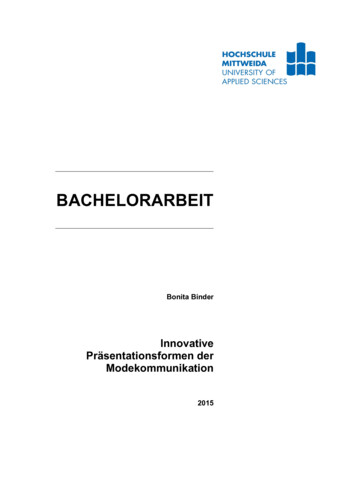
Transcription
Extracted from:Build Websites with HugoFast Web Development with MarkdownThis PDF file contains pages extracted from Build Websites with Hugo, publishedby the Pragmatic Bookshelf. For more information or to purchase a paperback orPDF copy, please visit http://www.pragprog.com.Note: This extract contains some colored text (particularly in code listing). Thisis available only in online versions of the books. The printed versions are blackand white. Pagination might vary between the online and printed versions; thecontent is otherwise identical.Copyright 2020 The Pragmatic Programmers, LLC.All rights reserved.No part of this publication may be reproduced, stored in a retrieval system, or transmitted,in any form, or by any means, electronic, mechanical, photocopying, recording, or otherwise,without the prior consent of the publisher.The Pragmatic BookshelfRaleigh, North Carolina
Build Websites with HugoFast Web Development with MarkdownBrian P. HoganThe Pragmatic BookshelfRaleigh, North Carolina
Many of the designations used by manufacturers and sellers to distinguish their productsare claimed as trademarks. Where those designations appear in this book, and The PragmaticProgrammers, LLC was aware of a trademark claim, the designations have been printed ininitial capital letters or in all capitals. The Pragmatic Starter Kit, The Pragmatic Programmer,Pragmatic Programming, Pragmatic Bookshelf, PragProg and the linking g device are trademarks of The Pragmatic Programmers, LLC.Every precaution was taken in the preparation of this book. However, the publisher assumesno responsibility for errors or omissions, or for damages that may result from the use ofinformation (including program listings) contained herein.Our Pragmatic books, screencasts, and audio books can help you and your team createbetter software and have more fun. Visit us at https://pragprog.com.The team that produced this book includes:Publisher: Andy HuntVP of Operations: Janet FurlowExecutive Editor: Dave RankinDevelopment Editor: Tammy CoronCopy Editor: Jasmine KwitynIndexing: Potomac Indexing, LLCLayout: Gilson GraphicsFor sales, volume licensing, and support, please contact support@pragprog.com.For international rights, please contact rights@pragprog.com.Copyright 2020 The Pragmatic Programmers, LLC.All rights reserved. No part of this publication may be reproduced, stored in a retrieval system,or transmitted, in any form, or by any means, electronic, mechanical, photocopying, recording,or otherwise, without the prior consent of the publisher.ISBN-13: 978-1-68050-726-3Encoded using the finest acid-free high-entropy binary digits.Book version: P1.0—May 2020
PrefaceAre you using a database to serve content that rarely changes? If you’re usingWordPress, Ghost, or other solutions for your content site, you probably are.Or at best, you’ve set up caching strategies to speed things up and reducedatabase calls.Database-driven content management systems like WordPress let you definea common theme shared across your site, making it a breeze to publish newcontent. However, since most content doesn’t change in real time, you’resacrificing speed and scalability for features that benefit content creators anddevelopers instead of the people who want to read your content. And thatadditional complexity means you need more resources in production too:more servers to handle the traffic, standby database servers, a caching layeryou have to manage, and more.There’s no better way to make a snappy content site than by serving staticpages from a traditional web server or a content delivery network (CDN). Butyou don’t have to give up the rapid development features you’ve come toexpect. Static site generators, like Hugo,1 give you a fantastic middle ground.You get the theming and content management features of a database-drivensite without the bloat, security vulnerabilities, or complexities associated withcaching.Hugo gives you a framework for building a fast, organized content site usingmany of the skills you already have. You define your layouts in HTML andyour content in Markdown. Hugo has built-in support for tagging, categorization, related content, multiple output formats, image optimization, and assethandling. While you’re developing your site, Hugo gives you a web server fortesting, and automatically refreshes your pages as you change them. Whenyou’re done building your site, Hugo generates a static site that you canupload to your web server.1.https://gohugo.io Click HERE to purchase this book now. discuss
Preface viThere are other static website generators available, like Jekyll2 and Gatsby,3two popular and well-known choices. Hugo has a few benefits over thoseother choices. First, Hugo uses a single binary with no dependencies, whichmeans you don’t need a complex build chain or additional runtimes like Nodeor Ruby to get started or use its features. Unlike Jekyll, Hugo doesn’t assumeyou’re creating a blog. And unlike Gatsby, you don’t need to learn React tobuild your themes or content; if you already know HTML and Markdown, youcan be productive right away. Finally, Hugo is incredibly fast when it comesto building the site. It can generate thousands of pages quickly, which comesin handy if you’re using Hugo to build something like a documentation website.In this book, you’ll use Hugo to build a personal portfolio site that you canuse to showcase your skills and thoughts to the world. You’ll build the basicskeleton, develop a custom theme, and use content templates to generatenew pages quickly. You’ll use internal and external data sources to embedcontent into your site, and render some of your content in JSON and RSS.You’ll add a blog section with posts and integrate Disqus with your site, andthen make your site searchable. While this isn’t a web design book, you’llintegrate modern CSS into the site, and use Hugo’s asset management featuresto process styles, images, and scripts. Then you’ll integrate Hugo with Node.jsand Webpack for those situations where you need a little more flexibility.Finally, you’ll explore deployment with Netlify,4 cloud storage, and traditionalweb hosts so you can share your work with the world.What’s in This BookEach chapter of the book covers a specific part of the development processwith Hugo.In Chapter 1, Kicking the Tires, on page ?, you’ll build the home page anda few supporting pages, along with a skeleton layout.Then, in Chapter 2, Building a Basic Theme, on page ?, you’ll transform thelayout into a custom theme for the site. You’ll break things up into reusablepieces and put everything in its place.In Chapter 3, Adding Content Sections, on page ?, you’ll create the projectssection of the site. You’ll work with custom content types and build out morecustomized layouts for your new content js.org/https://www.netlify.com/ Click HERE to purchase this book now. discuss
What You Need viiThen, you’ll integrate data into the site in Chapter 4, Working with Data, onpage ?. You’ll leverage front matter from your docs, data from external files,and data from external sites. You will also render some of your content asJSON data.In Chapter 5, Adding a Blog, on page ?, you’ll use what you’ve learned sofar to use Hugo to build a static blog. You’ll create a content template for blogposts, create a custom layout to control how your posts display, and addsupport for commenting. You’ll generate lists of posts, including a main listof posts in reverse chronological order, as well as lists for tags and categories.In Chapter 6, Adding Search to Your Site, on page ?, you’ll get search workingwith your site using a search index along with some client-side JavaScript.Next, in Chapter 7, Managing Assets with Pipes, on page ?, you’ll set up aproper asset pipeline so that you can manage your JavaScript and CSS filesmore easily. You’ll switch to using Sass for your stylesheets and explore someof Hugo’s built-in features for handling images. You’ll also look at integratingWebpack with Hugo, and using npm to manage tasks that make building yoursite easier.In Chapter 8, Deploying the Site, on page ?, you’ll explore a few methods tomove your site to production for the world to see. You’ll deploy to Netlify, thenlook at deploying to Amazon S3, and finally, how to deploy to more traditionalweb servers.Finally, you’ll find Appendix 1, Migrating to Hugo, on page ?, which exploresthe process of what it takes to move an existing site to Hugo.At the end of each chapter, you’ll find a few additional exercises that will helpcement your knowledge of the concepts.What You NeedYou’ll need your trusty text editor and some experience building things forthe web with HTML and CSS. This book doesn’t go into much detail aboutthose things and assumes you’ve built websites before. You won’t use anyCSS frameworks for the layout of your site, but you will use a small amountof modern CSS. The CSS you’ll use in this book is intended to demonstrateconcepts, not to substitute for careful and professional design. However, ifyou’re an experienced web developer, you’ll be able to see exactly where youcan apply your existing knowledge as you build out your design.Hugo runs on Windows, macOS, and various flavors of Linux and BSD operating systems, and it’s a single binary file with no dependencies. You’ll Click HERE to purchase this book now. discuss
Preface viiidownload and install Hugo in the first chapter. The examples of this bookuse Hugo version 0.68.3.Because Hugo is a command-line tool, you should be comfortable using thecommand-line interface (CLI). You’ll use the hugo command throughout thebook to build your site, launch a development server, and generate files. Ifyou want to get more comfortable with the CLI, you’ll find Small, SharpSoftware Tools [Hog19] helpful.The examples in this book will show CLI commands for copying and movingfiles. These commands will work in the macOS and Linux terminals, and theywill also work on Windows machines using the Windows Subsystem for Linuxif you’ve configured that. Alternatively, you can use your graphical environmentor text editor to manage and create files.Additionally, some experience with JavaScript will be helpful when integratingsearch into the site.Finally, in Chapter 5, Adding a Blog, on page ? and Chapter 7, ManagingAssets with Pipes, on page ?, you’ll use Node.js5 for some additional tooling.You should have Node.js installed on your system by following the officialinstallation instructions for your platform.ConventionsThroughout the book you’ll see commands like this: hugo new site portfolioThis is a command that you’ll type at your command-line interface. The dollarsign indicates the prompt. You won’t type that character.You’ll also see code listings, like this: div class "container" /div Sometimes, you’ll see highlighted sections when adding new lines of code,like this: div class "container" header h1 {{ .Site.title }} /h1 /header /div 5.https://nodejs.org Click HERE to purchase this book now. discuss
Online Resources ixYou’ll find instructions on where to add the code to your project with eachlisting, along with details on what the code does.Online ResourcesThe book’s website6 has links to submit errata for the book as well as thesource code for the sites you’ll build in this book. The downloadable sourcecode is there as a reference and contains the site as it exists at the end ofeach chapter.6.http://pragprog.com/book/bhhugo Click HERE to purchase this book now. discuss
the web with HTML and CSS. This book doesn’t go into much detail about those things and assumes you’ve built websites before. You won’t use any CSS frameworks for the layout of your site, but you will use a small amount of modern










